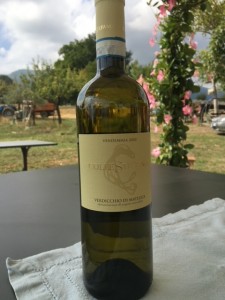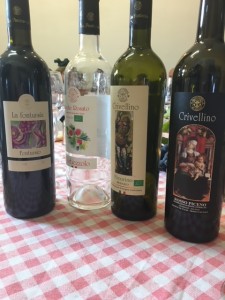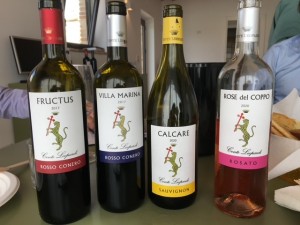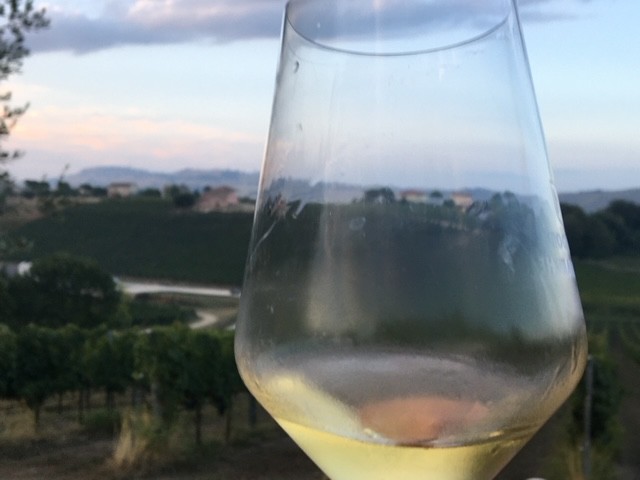Le Marche – The wine jewel of the Adriatic
Overlooking one of the Santa Liberata vineyards through a glass of Pecorino. PICTURED: TERRY DUARTE.
Most Italian wine lovers are familiar with Italy’s most famous wine regions: Piedmont, Tuscany and, to a lesser extent, Umbria, Campania and Sicily. All of these can be found on the Mediterranean side of Italy. However, on the Adriatic side of the mountains you will find excellent wines which, although somewhat unknown in the United States, are worth tasting. I now have the pleasure of presenting them to you, as well as the names of some of my favorite producers of these wines.
Over the past ten years, my wife and I have visited Le Marche – or Marche, as the natives call it – several times. Marche is a long, thin region stretching from Emilia-Romagna in the north to Abruzzo in the south. All of Marche is along the Adriatic Sea, parallel to the mountains, with much of it near the foothills. The grapes are grown both in the foothills regions and sometimes further inland. As with most of Italy, there are a number of different types of grapes in Le Marche, but I’ll focus on the most commonly grown types.
White Wines

A bottle of Verdicchio di Metalica from Colestafano. PHOTOS BY TERRY DUARTE.
Perhaps the best-known Marche white wine comes from the Verdicchio grape. Two different varieties are grown. The most important is the Verdicchio dei Castelli di Jesi, which is found in the vineyards around the town of Jesi. This Verdicchio produces a pleasant, dry, fresh and light white wine, excellent with seafood or as an aperitif. I like Verdicchios dei Castelli di Jesi by Umani Ronchi and Sartarelli, but there are many other good ones.
The second type of Verdicchio is called Verdicchio di Metalica. It is different because it is made from grapes grown in a different microclimate. Verdicchio dei Castelli grapes are grown in Adriatic vineyards and are affected by sea air and temperatures. Verdicchio di Metalica grapes are grown in vineyards much further inland and are not subject to the influence of the sea. The result is grapes that produce a more robust and crisp dry white wine with a higher alcohol content. Collestefano is an excellent example of Verdicchio di Metalica.

The wines of La Fortursia.
Other Marche whites that are gaining popularity in Italy and other parts of Europe are Pecorino and Passerina. Most wineries in the Offida and Ripatransone regions produce these two wines, with Pecorino being the most popular. Passerina is the lighter of the two. Both are excellent with seafood or as an aperitif. Among my favorites are the CiuCiu wines from the Offida region and the La Fontursia winery in Ripatransone. Merlettaie Offida Pecorino from CiuCiu and Crivellino Pecorino from La Fontursia are two excellent examples of this wine. I also include Passerina and Pecorino from the Santa Liberata winery in Lido di Fermo, where winemaker Martina Savini continues to produce excellent wines.
Another white grape variety is Ribona, also known as Maceratino Bianco. The wine from this variety is lighter than Verdicchio di Metalica, but interesting to drink. I like this wine and would like it to be better accepted. La Ribonna de Murola Winery is a prime example.
There are more different white wines produced in Le Marche, but these are the types you are likely to see the most.
Red Wines
Red grapes in Marche are not as plentiful as white ones. The predominant red grape varieties are Montepulciano and Sangiovese. A third native red grape variety is Lacrima.
The most found red wine is Rosso Piceno, normally a blend of 60-70% Montepulciano and 40-30% Sangiovese. Rosso Piceno is a very smooth, full-bodied wine and one of my favorite Italian blends. Two of my favorites are from the aforementioned wineries. These are the Gotica from CiuCiu and the Crivellino Rosso Piceno from La Fontursia.

The wines of Conte Leopardi.
Made from the same grapes but with different percentages (0-100% Montepulciano, the rest Sangiovese) is Rosso Conero, sometimes just called Conero. To be called Rosso Conero, all the grapes used must be grown in the Monte Conero reserve area. I really like the Conte Leopardi Pigmento Conero Riserva, a 100% Montepulciano grape wine, big but elegant and soft.
Another somewhat unique Marche wine is Lacrima di Morro d’Alba, a very aromatic wine that must be made from a minimum of 85% Lacrima grapes. It is not related to the Campanian wine Lacryma Christi. It’s a wine you either love or hate.
As in many other regions of Italy, you will also find French grape varieties grown in the Marches. The Le Sénat winery in Altidona produces a number of Bordeaux-inspired wines. My favorite is their Blu Velluto Spento, a 100% Cabernet Franc wine. Also, the Brunforte de Murola, a 100% Merlot wine, is excellent.
I have mentioned some of my favorite wineries, but there are a number of other good producers of all these wines in Le Marche. And if you’re looking for great seafood, I recommend Trattoria Trentesette in Porto Sant’Elpidio, where owner and wine lover Stefano Alessandrini will be happy to help you with a reasonably priced wine from his collection.


Comments are closed.